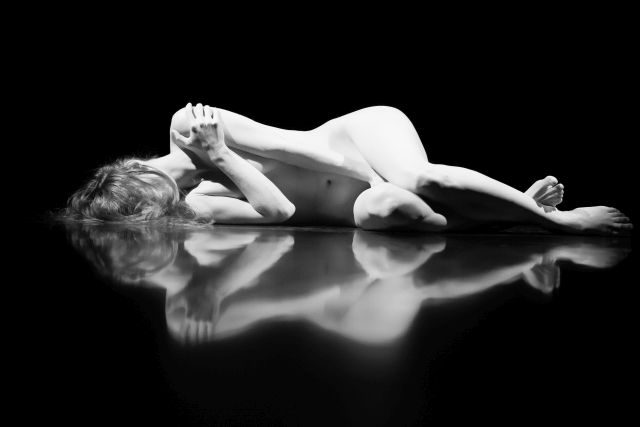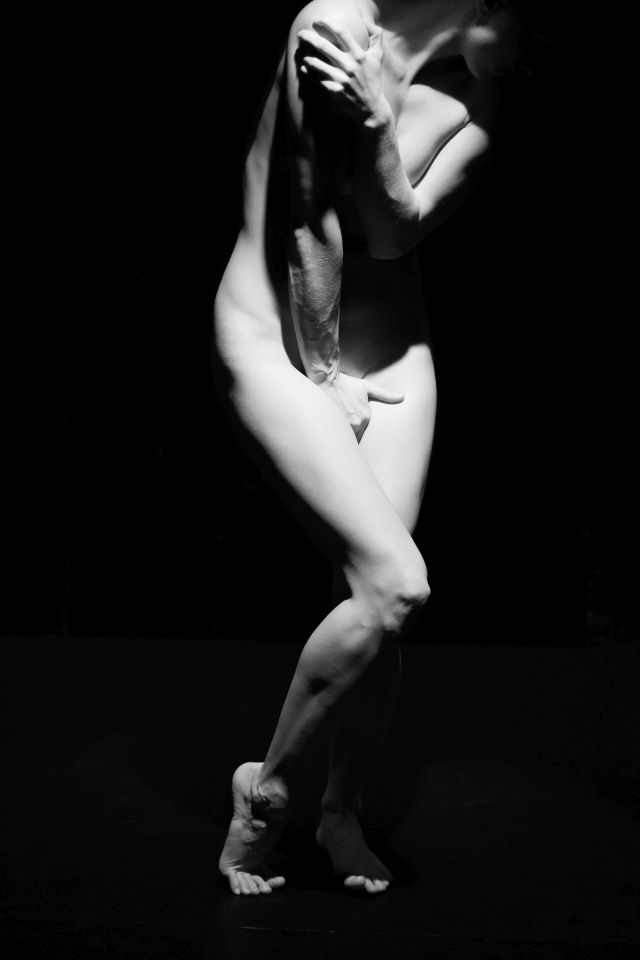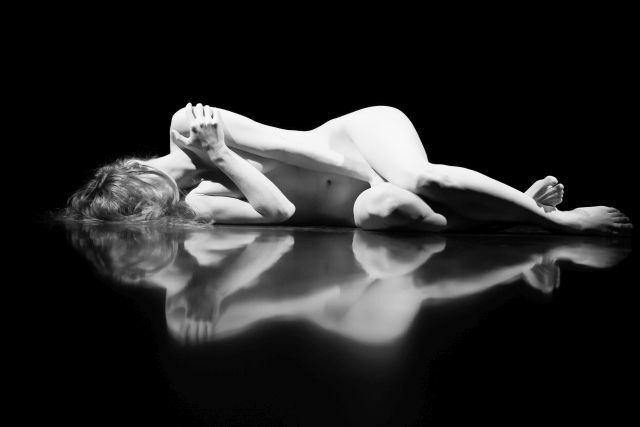 In her most recent production Anna Kukuczková, B.A., chose to venture into an unusual thematic area, undoubtedly for humane reasons and under pressure of information concerning serious social transgressions that – especially if capital crime is not commited – remain outside the public's attention. At the beginning of her production One does not talk about that the actress introduces herself by her real name and explains the meaning of her performance. Her work pursues the story of young girl Inna and psychological traumas experienced by victims of rape in particular, which in accordance with current scientific knowledge is seen rather as an act of torture than a sexual act. The production is thus conceived in a somewhat Brechtian manner, with a clear educative purpose; artistic interpretation of this topic obviously strives to explain the seriousness of sexual violence and its impact on the life of an individual. In her pursuit of this objective the author reconstructed the whole process on the stage, starting with the atrocious crime, slowly proceeding to a relative recovery of her character through the voice and motion sequences, the arrangement and content of which had been consulted with a psychiatrist. Director Radim Vizváry handled his part in a similarly thoughtful manner, so in a somewhat uneasy atmosphere of the unwelcoming premises of Roxy NoD any undesirable blunders such a controversial topic could bring about were successfully avoided. In the opening part of the production the protagonist introduces her character, an outgoing, quite ordinary girl in a rather traditional, predominantly pantomimic way. The following brutal rape scene is lit in such a way that the audience can catch
In her most recent production Anna Kukuczková, B.A., chose to venture into an unusual thematic area, undoubtedly for humane reasons and under pressure of information concerning serious social transgressions that – especially if capital crime is not commited – remain outside the public's attention. At the beginning of her production One does not talk about that the actress introduces herself by her real name and explains the meaning of her performance. Her work pursues the story of young girl Inna and psychological traumas experienced by victims of rape in particular, which in accordance with current scientific knowledge is seen rather as an act of torture than a sexual act. The production is thus conceived in a somewhat Brechtian manner, with a clear educative purpose; artistic interpretation of this topic obviously strives to explain the seriousness of sexual violence and its impact on the life of an individual. In her pursuit of this objective the author reconstructed the whole process on the stage, starting with the atrocious crime, slowly proceeding to a relative recovery of her character through the voice and motion sequences, the arrangement and content of which had been consulted with a psychiatrist. Director Radim Vizváry handled his part in a similarly thoughtful manner, so in a somewhat uneasy atmosphere of the unwelcoming premises of Roxy NoD any undesirable blunders such a controversial topic could bring about were successfully avoided. In the opening part of the production the protagonist introduces her character, an outgoing, quite ordinary girl in a rather traditional, predominantly pantomimic way. The following brutal rape scene is lit in such a way that the audience can catch
 only short, one-second glimpses of the struggling girl. The moment of psychological shock is followed by an entrance into a brightly lit chamber where something that we might call purification, realization of her condition or perhaps moving into the realm of the unconscious happens. At this point Anna Kukuczková brings forth other means of expression, closer to physical theatre with dance elements. Moments of stress are followed by aggression, which in turn is followed by withdrawal into herself in fear of the reactions of society. In the end the chains the character was bound in turn into a striking, non-removable necklace, symbolizing some a kind of common stigma.
In her rather short career Kukuczková has become an artistic persona, whose qualities are widely recognized among experts. Amazingly flexible, with a solid technical background, she performs her tasks with a remarkable proficiency. She is also sought after by both her colleagues and directors for her commitment to work and creative passion. This is coupled with her willingness to extend her skills beyond the genre boundaries – for instance in her inclination towards movement melodrama and in her participation in the company Tichá Opera (lately we got to see her in a charming role of a guide-maid in the recent premiere of Haydn's pantomime-opera Life on the Moon). Her tall, almost androgynous figure with regular facial features catches the eyes of audiences with her impressive performing as soon as she appears on the stage. In the course of the production One does not talk about that she uses the flexibility of her long limbs to twist them in an original morphology, at other points she prefers natural, yet despite the harsh reality of the situation still elegant movement. The whole performance was executed and tempered with remarkable precision and was therefore easy to understand, which is essential for the overall impact of the production; this was partially also due to psychologically realistic sequence of the changing mental condition of the protagonist. Still there is a slight doubt whether this piece, despite its difficult subject matter, would not benefit – but only cum grano salis – from even deeper emotional commitment in terms of bolstering the psychotherapeutic impact of this piece. A rather unconventional dramaturgy of this production itself indicates the process of emancipation of this artistic field, the representatives of which – besides Kukuczková there is for instance Vojtěch Svoboda in Havel's pantomime Perpetuum mobile and (probably as the very first person) one-generation older Vojtěch Švejda in his Platform – strive to depict in the language of pantomime the yet undiscovered, serious, contemporary issues. All three productions share the subject of a threat, however, they differ in local placement and social aspects. This inevitably raises the need for further expansion of the expressive means of young mimes, who in my opinion aim for a deeper, and therefore more universal concept of the genre, without forgetting its specific, purely physical means and procedures. They move away – sometimes even at the risk of misunderstanding – from the artistic limitations and social isolation of the genre as free-thinking artistic individualities. It is a process that can bring to the futuro of this field new programme and new energy.
In the genre of pantomime Anna Kukuczková intends to further develop the unique humane and psychotherapeutic aim of the production in collaboration with civil society Azyl Lisa.
only short, one-second glimpses of the struggling girl. The moment of psychological shock is followed by an entrance into a brightly lit chamber where something that we might call purification, realization of her condition or perhaps moving into the realm of the unconscious happens. At this point Anna Kukuczková brings forth other means of expression, closer to physical theatre with dance elements. Moments of stress are followed by aggression, which in turn is followed by withdrawal into herself in fear of the reactions of society. In the end the chains the character was bound in turn into a striking, non-removable necklace, symbolizing some a kind of common stigma.
In her rather short career Kukuczková has become an artistic persona, whose qualities are widely recognized among experts. Amazingly flexible, with a solid technical background, she performs her tasks with a remarkable proficiency. She is also sought after by both her colleagues and directors for her commitment to work and creative passion. This is coupled with her willingness to extend her skills beyond the genre boundaries – for instance in her inclination towards movement melodrama and in her participation in the company Tichá Opera (lately we got to see her in a charming role of a guide-maid in the recent premiere of Haydn's pantomime-opera Life on the Moon). Her tall, almost androgynous figure with regular facial features catches the eyes of audiences with her impressive performing as soon as she appears on the stage. In the course of the production One does not talk about that she uses the flexibility of her long limbs to twist them in an original morphology, at other points she prefers natural, yet despite the harsh reality of the situation still elegant movement. The whole performance was executed and tempered with remarkable precision and was therefore easy to understand, which is essential for the overall impact of the production; this was partially also due to psychologically realistic sequence of the changing mental condition of the protagonist. Still there is a slight doubt whether this piece, despite its difficult subject matter, would not benefit – but only cum grano salis – from even deeper emotional commitment in terms of bolstering the psychotherapeutic impact of this piece. A rather unconventional dramaturgy of this production itself indicates the process of emancipation of this artistic field, the representatives of which – besides Kukuczková there is for instance Vojtěch Svoboda in Havel's pantomime Perpetuum mobile and (probably as the very first person) one-generation older Vojtěch Švejda in his Platform – strive to depict in the language of pantomime the yet undiscovered, serious, contemporary issues. All three productions share the subject of a threat, however, they differ in local placement and social aspects. This inevitably raises the need for further expansion of the expressive means of young mimes, who in my opinion aim for a deeper, and therefore more universal concept of the genre, without forgetting its specific, purely physical means and procedures. They move away – sometimes even at the risk of misunderstanding – from the artistic limitations and social isolation of the genre as free-thinking artistic individualities. It is a process that can bring to the futuro of this field new programme and new energy.
In the genre of pantomime Anna Kukuczková intends to further develop the unique humane and psychotherapeutic aim of the production in collaboration with civil society Azyl Lisa.
Review of the performance held on November 20th, 2014 at the Experimental space NoD.
One does not talk about that
Concept and performance: Anna Kukuczkov
Dramaturgy: Anna Kukuczková and Radim Vizváry
Directed by: Radim Vizváry
Stage design: Jana Morávková
Music: Matouš Hejl
Light design: David Prokopič
Expert Advisor: Jakub Šiman, MD. Premiere: May 25th, 2014, NoD
Review by: Ladislava Petišková
Theatre critic Translation by: Tomáš Valníček




Josef Bartos
Thank you for your thoughts. One got stuck in my mind – that passion makes us different from AI. Just yesterday I read…I am a dance critic. I am a member of an endangered species